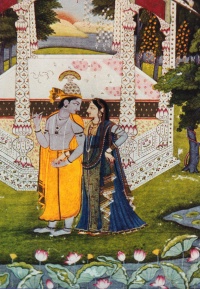Krishna: Difference between revisions
(Editor's own synthesis, not suppurted by a Gurmat citation.) |
|||
| Line 6: | Line 6: | ||
=='''Krishna''', in Gurmat== | =='''Krishna''', in Gurmat== | ||
The word | The word Krishna literally means dark or black in colour. In Gurbani his treatment is left somewhat ambiguous. At times he is described as a mortal and sometimes as metaphor for divine charmer. In the general Vaishnavite imagination, Krishna is the Supreme Being. However, more per the esoteric interpretation of Krisna legend can be seen as a spiritual allegory in which, Gopis represent the outward inclination of human mind which are charmed back into a divine inner state by Krishna's magical flute. Krishna's magic flute is often seen as the sound of "OM" equivalent of Gurbani's "Ik Onkar" which is naturally heard, by a sincere devotee in deep meditative state. However, Gurbani does not explicitly state this interpretation of Krishna and Gopis and leaves an exhilrating but unresolved poetic tension about the term. | ||
Some other popular names of Krishna which also appear in Gurbani are Madho (Madhav), Madhusudan, Kanha, Banwari, etc which are often found in the Vaishnavite tradition. Unlike Vaishnavite tradition in which Krishna is always a metaphor for Supreme Being, the treatment of Krishna in Sikh tradtion is a lot more nuanced and appears in a variety of allegorical and literal contexts. | |||
Every person is Krisna and Ram is present in every person. Hindus are not able to say that both are different but as they did not understand their concept and made Brindaban, Dwarka, Ayodhya outside how could they say them one? Gurmat says that Barindaban, Dwarka, spirit and Ram is inside every human, now Gurma,t the Path of Wisdom, has proven Krisna and Ram are same. Krisna is inside us and ram is inside us only. | |||
==Both word and Devta== | ==Both word and Devta== | ||
Revision as of 11:27, 25 July 2010
| ਜਗ ਦਆਪਰ ਆਇਆ ਭਰਮਿ ਭਰਮਾਇਆ ਹਰਿ ਗੋਪੀ ਕਾਨਹਹ ਉਪਾਇ ਜੀਉ ॥ |
| Jug ḝuĝpur ĝiĝ bẖaram bẖarmĝiĝ har gopī kĝnĥ upĝė jīo. |
| The Brass Age of Dwaapar Yuga came, and people wandered in doubt. The Lord created the Gopis and Krishna. |
Krishna, in Gurmat
The word Krishna literally means dark or black in colour. In Gurbani his treatment is left somewhat ambiguous. At times he is described as a mortal and sometimes as metaphor for divine charmer. In the general Vaishnavite imagination, Krishna is the Supreme Being. However, more per the esoteric interpretation of Krisna legend can be seen as a spiritual allegory in which, Gopis represent the outward inclination of human mind which are charmed back into a divine inner state by Krishna's magical flute. Krishna's magic flute is often seen as the sound of "OM" equivalent of Gurbani's "Ik Onkar" which is naturally heard, by a sincere devotee in deep meditative state. However, Gurbani does not explicitly state this interpretation of Krishna and Gopis and leaves an exhilrating but unresolved poetic tension about the term.
Some other popular names of Krishna which also appear in Gurbani are Madho (Madhav), Madhusudan, Kanha, Banwari, etc which are often found in the Vaishnavite tradition. Unlike Vaishnavite tradition in which Krishna is always a metaphor for Supreme Being, the treatment of Krishna in Sikh tradtion is a lot more nuanced and appears in a variety of allegorical and literal contexts.
Every person is Krisna and Ram is present in every person. Hindus are not able to say that both are different but as they did not understand their concept and made Brindaban, Dwarka, Ayodhya outside how could they say them one? Gurmat says that Barindaban, Dwarka, spirit and Ram is inside every human, now Gurma,t the Path of Wisdom, has proven Krisna and Ram are same. Krisna is inside us and ram is inside us only.
Both word and Devta
Krishna (कृषढ़ण in Devanagari, kṛṣṇa in IAST, is a deity worshipped across many traditions in Hinduism in a variety of perspectives. While many Vaishnava groups recognize Krishna as an avatar of Vishnu, other traditions within Krishnaism consider him to be svayam bhagavan, or the Supreme Being.
The Sanskrit word kṛṣṇa means "black", "dark" or "dark-blue". It is often used as a name to describe someone with dark skin. Krishna is often depicted in murtis (idols) as black, and is generally shown in paintings with a blue skin.
Krishna is often depicted as an infant or young boy playing a flute as in the Bhagavata Purana, or as a youthful prince giving direction and guidance as in the Bhagavad Gita. The stories of Krishna appear across a broad spectrum of Hindu philosophical and theological traditions.
They portray him in various perspectives: a god-child, a prankster, a model lover, a divine hero and the Supreme Being. The principal scriptures discussing Krishna's story are the Mahabharata, the Harivamsa, the Bhagavata Purana and the Vishnu Purana.
| ਆਪੇ ਗੋਪੀ ਕਾਨ ਹੈ ਪਿਆਰਾ ਬਨਿ ਆਪੇ ਗਊ ਚਰਾਹਾ ॥ ਆਪੇ ਸਾਵਲ ਸੰਦਰਾ ਪਿਆਰਾ ਆਪੇ ਵੰਸ ਵਜਾਹਾ ॥ |
| Āpė gopī kĝn hai piĝrĝ ban ĝpė gaū cẖarĝhĝ. Āpė sĝval sunḝrĝ piĝrĝ ĝpė vans vajĝhĝ. |
| The Beloved Himself is the milk-maid and Krishna; He Himself herds the cows in the woods. The Beloved Himself is the blue-skinned, handsome one; He Himself plays on His flute. |
- See Wikipedia article on Krishna for more information

